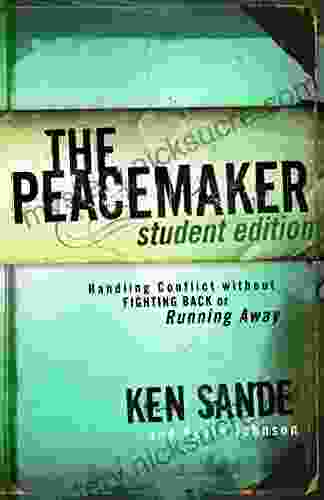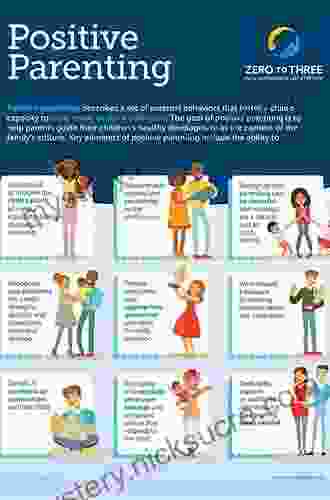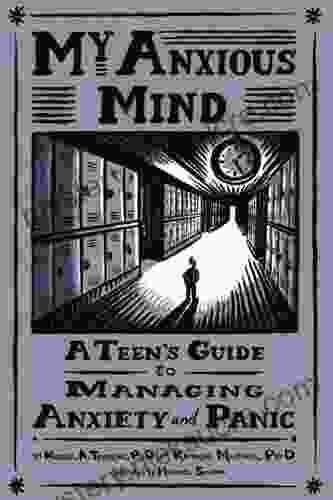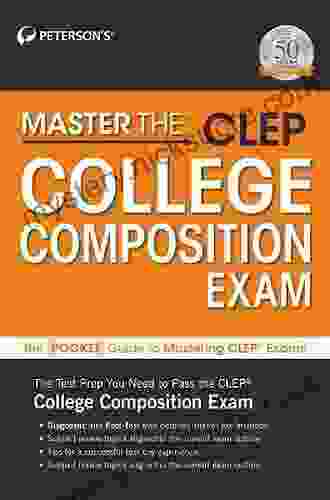Handling Conflict Without Fighting Back Or Running Away: A Comprehensive Guide to Resolving Disputes Healthily

Conflict is an unavoidable part of life. It can arise in any setting, from personal relationships to professional environments. While it is natural to feel defensive or upset when faced with conflict, it is essential to learn how to handle it constructively to maintain healthy relationships and resolve issues effectively. Fighting back or running away from conflict are not viable solutions, as they can escalate tensions and leave underlying problems unresolved.
To effectively handle conflict, it is crucial to understand the different conflict styles people may adopt. The five main conflict styles are:
Competing: Individuals who adopt this style focus on achieving their own goals at the expense of others. They may be forceful, aggressive, and unwilling to compromise.
The Peacemaker: Handling Conflict without Fighting Back or Running Awayby Ken Sande4.6 out of 5
Language : English File size : 3513 KB Text-to-Speech : Enabled Screen Reader : Supported Enhanced typesetting : Enabled Word Wise : Enabled Print length : 177 pages Lending : Enabled Avoiding: This style involves avoiding conflict altogether. Individuals may deny there is a problem, withdraw from situations, or procrastinate on addressing issues.
Accommodating: Individuals who accommodate prioritize the needs of others over their own. They may be too willing to compromise, even when their own interests are compromised.
Compromising: This style involves finding a middle ground between competing interests. Individuals may negotiate and make concessions to reach a mutually acceptable solution.
Collaborating: The collaborating style emphasizes finding solutions that meet the needs of all parties involved. Individuals work together to find creative solutions that address underlying issues and build stronger relationships.
Constructive conflict resolution techniques aim to resolve disputes peacefully and amicably. Some effective techniques include:
Active Listening: Pay undivided attention to the other person's perspective. Show empathy and understanding by acknowledging their feelings and restating their points of view without judgment.
Non-Verbal Communication: Maintain eye contact, nod, and use appropriate body language to convey respect and attentiveness. Avoid accusatory or dismissive gestures.
"I" Statements: Express your thoughts and feelings using "I" statements. This helps avoid blaming or attacking others and takes ownership of your perspective. For example, instead of saying "You always make me feel bad," try "I feel hurt when certain things are said."
Focus on Interests, Not Positions: Identify the underlying interests or needs that are driving the conflict. Focus on finding solutions that address those interests rather than getting stuck on specific positions.
Use "And" Statements: Instead of using "but" statements that negate the other person's opinion, use "and" to acknowledge their perspective while expressing your own. For instance, instead of saying "You're wrong, but I think...," try "I understand your point, and I also feel..."
Set a Time-Out: If emotions are running high, it may be helpful to take a break. Agree on a time to return to the conversation when both parties are calmer and more receptive.
While it is important to confront conflict head-on, it is equally crucial to avoid physical or emotional confrontations that can escalate the situation. Some strategies include:
Establish Boundaries: Clearly communicate your boundaries and expectations to avoid misunderstandings and potential triggers. This includes respecting personal space, avoiding disrespectful language, and setting limits on certain topics.
Identify Your Triggers: Understand what situations or behaviors tend to trigger negative reactions in you. Once you know your triggers, you can develop strategies for managing your emotions and de-escalating conflict.
Walk Away: If the situation becomes too intense or overwhelming, it is acceptable to walk away. Let the other person know that you need some time to calm down and collect your thoughts before continuing the conversation.
Seek Support: Talk to a trusted friend, family member, therapist, or mediator to gain an outside perspective and support. They can provide valuable insights and help you develop coping mechanisms.
Focus on the Present: Avoid bringing up past conflicts or unrelated issues. This will only serve to distract from the current problem and escalate tensions.
Resolving conflict constructively offers numerous benefits, including:
Improved Relationships: Healthy conflict resolution helps strengthen relationships by building trust, respect, and understanding.
Increased Productivity: Unresolved conflict can hinder productivity and create a negative work environment. Constructive resolution ensures that issues are addressed and solutions are found, fostering a more positive and productive atmosphere.
Personal Growth: Conflict can be an opportunity for personal growth and development. By learning to handle it effectively, you can improve your communication skills, strengthen your emotional resilience, and enhance your ability to collaborate with others.
Handling conflict effectively is a valuable life skill that can significantly improve personal and professional relationships. By understanding different conflict styles, adopting constructive resolution techniques, and avoiding physical or emotional conflict, you can navigate disputes peacefully and amicably. Remember that conflict is not something to be avoided or feared, but rather an opportunity for growth and connection. By embracing constructive conflict resolution, you can build stronger relationships, resolve issues, and create a more positive and fulfilling life.
4.6 out of 5
| Language | : | English |
| File size | : | 3513 KB |
| Text-to-Speech | : | Enabled |
| Screen Reader | : | Supported |
| Enhanced typesetting | : | Enabled |
| Word Wise | : | Enabled |
| Print length | : | 177 pages |
| Lending | : | Enabled |
Do you want to contribute by writing guest posts on this blog?
Please contact us and send us a resume of previous articles that you have written.
 Fiction
Fiction Non Fiction
Non Fiction Romance
Romance Mystery
Mystery Thriller
Thriller SciFi
SciFi Fantasy
Fantasy Horror
Horror Biography
Biography Selfhelp
Selfhelp Business
Business History
History Classics
Classics Poetry
Poetry Childrens
Childrens Young Adult
Young Adult Educational
Educational Cooking
Cooking Travel
Travel Lifestyle
Lifestyle Spirituality
Spirituality Health
Health Fitness
Fitness Technology
Technology Science
Science Arts
Arts Crafts
Crafts DIY
DIY Gardening
Gardening Petcare
Petcare Nicola Yoon
Nicola Yoon Albert Rutherford
Albert Rutherford Terry Laughlin
Terry Laughlin Jim Kempton
Jim Kempton Tina Schindler
Tina Schindler Michael A Tompkins
Michael A Tompkins Tyler Trent
Tyler Trent Thomas Carothers
Thomas Carothers Craig Callender
Craig Callender Eugenia G Kelman
Eugenia G Kelman John Moren
John Moren Tim Glover
Tim Glover William Rathje
William Rathje Arrl Inc
Arrl Inc Howard E Mccurdy
Howard E Mccurdy Lingo Mastery
Lingo Mastery Elizabeth May
Elizabeth May Michael Blastland
Michael Blastland Fiona Beddall
Fiona Beddall Lottie Bildirici
Lottie Bildirici David Wilber
David Wilber Scott Hartshorn
Scott Hartshorn Oliver Sacks
Oliver Sacks Jennifer Appel
Jennifer Appel Nicola S Dorrington
Nicola S Dorrington Warwick Deeping
Warwick Deeping Thomas Achatz
Thomas Achatz Stian Christophersen
Stian Christophersen Healthfit Publishing
Healthfit Publishing Leah Hazard
Leah Hazard Romola Anderson
Romola Anderson Denise May Levenick
Denise May Levenick Ed Housewright
Ed Housewright Luc Mehl
Luc Mehl Dianne Maroney
Dianne Maroney Darcy Lever
Darcy Lever Donna Goldberg
Donna Goldberg David Cannon
David Cannon Michael Chatfield
Michael Chatfield Byron L Reeder
Byron L Reeder Lisa Hopp
Lisa Hopp S M Kingdom
S M Kingdom Christine Mari Inzer
Christine Mari Inzer Destiny S Harris
Destiny S Harris Rick Trickett
Rick Trickett Sophie Messager
Sophie Messager Matt Mullenix
Matt Mullenix Maren Stoffels
Maren Stoffels Jennifer Rose
Jennifer Rose Tom Cunliffe
Tom Cunliffe Bruce Sutherland
Bruce Sutherland Shawna Richer
Shawna Richer John J Ratey
John J Ratey Frank Muir
Frank Muir Ronald T Potter Efron
Ronald T Potter Efron Jesse Romero
Jesse Romero Kelly Rowland
Kelly Rowland Buddy Levy
Buddy Levy Richard W Voelz
Richard W Voelz Dan Flores
Dan Flores Collins Easy Learning
Collins Easy Learning Carlos I Calle
Carlos I Calle Lee Jackson
Lee Jackson Katherine D Kinzler
Katherine D Kinzler Stacey Rourke
Stacey Rourke Charles Staley
Charles Staley Judith Merkle Riley
Judith Merkle Riley Neville Goddard
Neville Goddard Richard Bullivant
Richard Bullivant Charles Salzberg
Charles Salzberg Susan Orlean
Susan Orlean Jared Diamond
Jared Diamond Lynette Noni
Lynette Noni Db King
Db King Shmuel Goldberg
Shmuel Goldberg Tamara Ferguson
Tamara Ferguson Rowena Bennett
Rowena Bennett Mike X Cohen
Mike X Cohen Joel Best
Joel Best Veronica Eden
Veronica Eden Lily Field
Lily Field Sophie D Coe
Sophie D Coe Carol Inskipp
Carol Inskipp Valliappa Lakshmanan
Valliappa Lakshmanan Nick Gamis
Nick Gamis Joanne Kimes
Joanne Kimes Ira K Wolf
Ira K Wolf Kaplan Test Prep
Kaplan Test Prep Megan Miller
Megan Miller John R Mabry
John R Mabry Issai Chozanshi
Issai Chozanshi Matt Price
Matt Price Elisabeth Elliot
Elisabeth Elliot Stephen Harrison
Stephen Harrison Francis Glebas
Francis Glebas Katharine Mcgee
Katharine Mcgee Nick Tumminello
Nick Tumminello Hecateus Apuliensis
Hecateus Apuliensis Philip Purser Hallard
Philip Purser Hallard Erin Beaty
Erin Beaty Paul Murdin
Paul Murdin Jane Brocket
Jane Brocket Mcgraw Hill
Mcgraw Hill Sarah Baker
Sarah Baker Jennifer L Scott
Jennifer L Scott Scarlett V Clark
Scarlett V Clark Heather Jacobson
Heather Jacobson Susan Frederick Gray
Susan Frederick Gray Linda Rosenkrantz
Linda Rosenkrantz Maha Alkurdi
Maha Alkurdi Larry Larsen
Larry Larsen Jack Canfield
Jack Canfield Meghan Daum
Meghan Daum Chad Eastham
Chad Eastham Emma Warren
Emma Warren Leon Speroff
Leon Speroff Freya Pickard
Freya Pickard Kevin Houston
Kevin Houston Dave Bosanko
Dave Bosanko Craig Martelle
Craig Martelle Ron Rapoport
Ron Rapoport Joe Baker
Joe Baker Mark Stavish
Mark Stavish K C Cole
K C Cole Kruti Joshi
Kruti Joshi Stedman Graham
Stedman Graham Malika Grayson
Malika Grayson Theodora Papatheodorou
Theodora Papatheodorou Shaunti Feldhahn
Shaunti Feldhahn Leah Zani
Leah Zani Kathy Woods
Kathy Woods Nawuth Keat
Nawuth Keat Kevin A Morrison
Kevin A Morrison Lynn Butler Kisber
Lynn Butler Kisber Henry Malone
Henry Malone Melissa Mullamphy
Melissa Mullamphy Jim Warnock
Jim Warnock Jim West
Jim West Ransom Riggs
Ransom Riggs Meg Cabot
Meg Cabot J R Harris
J R Harris Sallyann Beresford
Sallyann Beresford Emily Writes
Emily Writes Veronica Roth
Veronica Roth Julie Golob
Julie Golob Jess J James
Jess J James Mark Young
Mark Young William L Sullivan
William L Sullivan Ken Schwaber
Ken Schwaber Kat Davis
Kat Davis Narain Moorjani
Narain Moorjani Chris Bonington
Chris Bonington Vladimir Lossky
Vladimir Lossky Pam Flowers
Pam Flowers Jessica Holsman
Jessica Holsman J D Williams
J D Williams Troy Horne
Troy Horne Charu C Aggarwal
Charu C Aggarwal Nicholas Tomalin
Nicholas Tomalin David Nathan Fuller
David Nathan Fuller Upton Sinclair
Upton Sinclair David Savedge
David Savedge C M Carney
C M Carney Helen Zuman
Helen Zuman Sterling Test Prep
Sterling Test Prep Sarah Jacoby
Sarah Jacoby L W Jacobs
L W Jacobs Olivier Doleuze
Olivier Doleuze Tony E Adams
Tony E Adams W D Wetherell
W D Wetherell Dan Romanchik Kb6nu
Dan Romanchik Kb6nu William Ian Miller
William Ian Miller C S Lewis
C S Lewis Mo Gawdat
Mo Gawdat Jen Howver
Jen Howver Dounya Awada
Dounya Awada Dian Olson Belanger
Dian Olson Belanger Skip Lockwood
Skip Lockwood Bryce Carlson
Bryce Carlson Ron Senyor
Ron Senyor Suzanne Young
Suzanne Young Ashley Christensen
Ashley Christensen Ronit Irshai
Ronit Irshai Lee Alan Dugatkin
Lee Alan Dugatkin Michael Lear Hynson
Michael Lear Hynson Kevin Howell
Kevin Howell Bruce Maxwell
Bruce Maxwell Steven W Dulan
Steven W Dulan John Burroughs
John Burroughs Dave Rearick
Dave Rearick Marla Taviano
Marla Taviano Shea Ernshaw
Shea Ernshaw Richard Drake
Richard Drake Ralph Galeano
Ralph Galeano Keith Brewer
Keith Brewer Silvia Dunn
Silvia Dunn Mark Hansen
Mark Hansen Jim Al Khalili
Jim Al Khalili Martha Finley
Martha Finley Leslie A Sams
Leslie A Sams Rob Pate
Rob Pate William Ellet
William Ellet Cornelia Pelzer Elwood
Cornelia Pelzer Elwood William Wood
William Wood Gary Lewis
Gary Lewis Jacob Erez
Jacob Erez Joseph Moss
Joseph Moss Kevin Panetta
Kevin Panetta Maurice J Thompson
Maurice J Thompson Richard Harding Davis
Richard Harding Davis Dorothy Canfield Fisher
Dorothy Canfield Fisher Robert Walker
Robert Walker Katie Fallon
Katie Fallon Lsat Unplugged
Lsat Unplugged William M Baum
William M Baum Tim S Grover
Tim S Grover Robert Larrison
Robert Larrison Ivar Dedekam
Ivar Dedekam James Beard
James Beard Tricia Levenseller
Tricia Levenseller Sarah Berman
Sarah Berman Konstantinos Mylonas
Konstantinos Mylonas Carole Bouchard
Carole Bouchard Mathew Orton
Mathew Orton Earl G Williams
Earl G Williams Sherri L Jackson
Sherri L Jackson Nick Littlehales
Nick Littlehales Guy Grieve
Guy Grieve Jim Supica
Jim Supica E Ink Utilizer
E Ink Utilizer Rand Cardwell
Rand Cardwell Daniel Prince
Daniel Prince Roger Marshall
Roger Marshall Barbara Acello
Barbara Acello Fern Schumer Chapman
Fern Schumer Chapman Vincent Chidindu Asogwa
Vincent Chidindu Asogwa Bunmi Laditan
Bunmi Laditan Michael D Alessio
Michael D Alessio Elmer Keith
Elmer Keith Oprah Winfrey
Oprah Winfrey Carrie Marie Bratley
Carrie Marie Bratley Nicolas Bergeron
Nicolas Bergeron Deirdre V Lovecky
Deirdre V Lovecky Steven Kerry Brown
Steven Kerry Brown Cal Newport
Cal Newport Meriwether Lewis
Meriwether Lewis Ian Leslie
Ian Leslie Vivian Foster
Vivian Foster Mark Stanton
Mark Stanton Dina Nayeri
Dina Nayeri Jasmine Shao
Jasmine Shao Justin Coulson
Justin Coulson Joanne V Hickey
Joanne V Hickey Caroline Manta
Caroline Manta Karen J Rooney
Karen J Rooney John Vince
John Vince Jimmy Chin
Jimmy Chin George Daniel
George Daniel Emily Lowry
Emily Lowry Duncan Steel
Duncan Steel Sarah Prager
Sarah Prager James W Anderson
James W Anderson Jill Angie
Jill Angie Cameron Mcwhirter
Cameron Mcwhirter Donna R Causey
Donna R Causey Peter J D Adamo
Peter J D Adamo Mona Bijjani
Mona Bijjani Mary Pagones
Mary Pagones R L Medina
R L Medina Sam Priestley
Sam Priestley Sammy Franco
Sammy Franco Steve Guest
Steve Guest Scott Cawthon
Scott Cawthon Marc Bona
Marc Bona Winslow Tudor
Winslow Tudor Greg W Prince
Greg W Prince Marcia Scheiner
Marcia Scheiner Michael Tan
Michael Tan Leslie R Schover
Leslie R Schover Lina K Lapina
Lina K Lapina Paul Rabinow
Paul Rabinow Julia Ann Clayton
Julia Ann Clayton Scott Mactavish
Scott Mactavish Niels H Lauersen
Niels H Lauersen Hugh Aldersey Williams
Hugh Aldersey Williams Shelby Hailstone Law
Shelby Hailstone Law Emt Basic Exam Prep Team
Emt Basic Exam Prep Team Michael Mewshaw
Michael Mewshaw Robert Edward Grant
Robert Edward Grant Stephen King
Stephen King Elizabeth Laing Thompson
Elizabeth Laing Thompson Creek Stewart
Creek Stewart Don Allen Jr
Don Allen Jr Kendall Rose
Kendall Rose Melissa A Priblo Chapman
Melissa A Priblo Chapman Jessica Howard
Jessica Howard Richard Barrett
Richard Barrett Max Lucado
Max Lucado Nedu
Nedu John M Marzluff
John M Marzluff Rita Golden Gelman
Rita Golden Gelman Fmg Publications Special Edition
Fmg Publications Special Edition Helen Webster
Helen Webster Jamie Marich
Jamie Marich Shyima Hall
Shyima Hall James Goi Jr
James Goi Jr David Eagleman
David Eagleman Sheri Morehouse
Sheri Morehouse Ned Feehally
Ned Feehally Lianna Marie
Lianna Marie Phil Bourque
Phil Bourque Robert D Gibbons
Robert D Gibbons Peterson S
Peterson S Douglas P Fry
Douglas P Fry Zachery Knowles
Zachery Knowles Dory Willer
Dory Willer Lois Lowry
Lois Lowry Kacen Callender
Kacen Callender Chris Morton
Chris Morton J Maarten Troost
J Maarten Troost James Miller
James Miller Caleb J Tzilkowski
Caleb J Tzilkowski Dennis Adler
Dennis Adler Michelle Travis
Michelle Travis Erin Macy
Erin Macy Jeffrey L Kohanek
Jeffrey L Kohanek Scott Mcmillion
Scott Mcmillion Dr Monika Chopra
Dr Monika Chopra Hibiki Yamazaki
Hibiki Yamazaki Ian Tuhovsky
Ian Tuhovsky Phil Williams
Phil Williams Huberta Wiertsema
Huberta Wiertsema Don S Lemons
Don S Lemons Della Ata Khoury
Della Ata Khoury Marco Wenisch
Marco Wenisch E W Barton Wright
E W Barton Wright Bruce Watt
Bruce Watt Wyatt Mcspadden
Wyatt Mcspadden Thomas Deetjen
Thomas Deetjen The Atavist
The Atavist Mary C Townsend
Mary C Townsend Jack Disbrow Gunther
Jack Disbrow Gunther Jeff Scheetz
Jeff Scheetz David Martin
David Martin Pedro Urvi
Pedro Urvi Marisa Peer
Marisa Peer Lisa Feldman Barrett
Lisa Feldman Barrett Jason Runkel Sperling
Jason Runkel Sperling Bryan Litz
Bryan Litz Bruce W Harris
Bruce W Harris John Flanagan
John Flanagan John Jamieson
John Jamieson Doug Cook
Doug Cook Celeste Headlee
Celeste Headlee Simon A Rego
Simon A Rego Thomas Daniels
Thomas Daniels Frederick Jackson Turner
Frederick Jackson Turner David Tanis
David Tanis Eric P Lane
Eric P Lane Max Prasac
Max Prasac Matthew Warner Osborn
Matthew Warner Osborn Joyceen S Boyle
Joyceen S Boyle Wilhelm Reich
Wilhelm Reich Dr Tommy John
Dr Tommy John Eric R Dodge
Eric R Dodge Sara Gaviria
Sara Gaviria Tey Meadow
Tey Meadow Sylvia Williams Dabney
Sylvia Williams Dabney Rebecca Musser
Rebecca Musser John Kretschmer
John Kretschmer Kyra Phillips
Kyra Phillips Samantha De Senna Fernandes
Samantha De Senna Fernandes Brandy Colbert
Brandy Colbert Max Lugavere
Max Lugavere Simon Michael Prior
Simon Michael Prior Melanie Anne Phillips
Melanie Anne Phillips Philippe Karl
Philippe Karl Martin Davies
Martin Davies Richard Henry Dana
Richard Henry Dana C F Crist
C F Crist Elizabeth Anne Wood
Elizabeth Anne Wood Ivy Hope
Ivy Hope Om Krishna Uprety
Om Krishna Uprety Dvora Meyers
Dvora Meyers Clement Salvadori
Clement Salvadori Tom Bass
Tom Bass Cathy Glass
Cathy Glass Julietta Suzuki
Julietta Suzuki Dick Hannula
Dick Hannula Lewis Kirkham
Lewis Kirkham Graham Norton
Graham Norton Kathleen Flinn
Kathleen Flinn Lily Raff Mccaulou
Lily Raff Mccaulou Albert Jeremiah Beveridge
Albert Jeremiah Beveridge Pamela Weintraub
Pamela Weintraub Michael Gurian
Michael Gurian Tyler Burt
Tyler Burt Nikki Carroll
Nikki Carroll Matt Baglio
Matt Baglio Matthew Marchon
Matthew Marchon Douglas Preston
Douglas Preston Jim Wiese
Jim Wiese Kindle Edition
Kindle Edition Charles Sanger
Charles Sanger R Scott Thornton
R Scott Thornton Diane Lindsey Reeves
Diane Lindsey Reeves Maria Van Noord
Maria Van Noord Victoria Honeybourne
Victoria Honeybourne Steve Barrett
Steve Barrett Lauren Manoy
Lauren Manoy Nigel Cawthorne
Nigel Cawthorne Cassandra Mack
Cassandra Mack Ashley Eckstein
Ashley Eckstein Paul Lobo
Paul Lobo Trevelyan
Trevelyan Trevor Thomas
Trevor Thomas C J Archer
C J Archer John H Cunningham
John H Cunningham Edward Humes
Edward Humes Kerry H Cheever
Kerry H Cheever Tibor Rutar
Tibor Rutar Martina D Antiochia
Martina D Antiochia Natasha Daniels
Natasha Daniels Maxine A Goldman
Maxine A Goldman Aaron Reed
Aaron Reed Ken Sande
Ken Sande Matt Racine
Matt Racine Natasha Ngan
Natasha Ngan Sonia Shah
Sonia Shah Sheila A Sorrentino
Sheila A Sorrentino Tanya Hackney
Tanya Hackney Lew Freedman
Lew Freedman Caitlyn Dare
Caitlyn Dare Valerie Poore
Valerie Poore Robert Moor
Robert Moor Gary Mayes
Gary Mayes Ruthellen Josselson
Ruthellen Josselson Norman Thelwell
Norman Thelwell Carrie Hope Fletcher
Carrie Hope Fletcher Jeff Belanger
Jeff Belanger Graham Hancock
Graham Hancock Law School Admission Council
Law School Admission Council Carmen Davenport
Carmen Davenport Chris Pountney
Chris Pountney Winky Lewis
Winky Lewis Heather Balogh Rochfort
Heather Balogh Rochfort Martina Mcbride
Martina Mcbride Elena Paige
Elena Paige J R Rain
J R Rain Robert Garland
Robert Garland Jonathan T Gilliam
Jonathan T Gilliam Stella Cottrell
Stella Cottrell Orangepen Publications
Orangepen Publications Elaine Tyler May
Elaine Tyler May John Grehan
John Grehan Lucy Cooke
Lucy Cooke Laurie Notaro
Laurie Notaro Roger J Davies
Roger J Davies Richard C Francis
Richard C Francis Robert A Cutietta
Robert A Cutietta Tim Freke
Tim Freke Marc Van Den Bergh
Marc Van Den Bergh Declan Lyons
Declan Lyons Cecil B Hartley
Cecil B Hartley Joseph Correa
Joseph Correa Bruce Van Brunt
Bruce Van Brunt Peter Bodo
Peter Bodo Elizabeth Dupart
Elizabeth Dupart Susan Garcia
Susan Garcia Pat Rigsby
Pat Rigsby M E Brines
M E Brines Janet Evans
Janet Evans Pia Nilsson
Pia Nilsson Wayne Coffey
Wayne Coffey Paul A Offit
Paul A Offit Sandra Niche
Sandra Niche Ivan Gridin
Ivan Gridin Paige Powers
Paige Powers Gregory A Kompes
Gregory A Kompes John H Falk
John H Falk Sue Elvis
Sue Elvis Sarah Ockwell Smith
Sarah Ockwell Smith Anthony Camera
Anthony Camera
Light bulbAdvertise smarter! Our strategic ad space ensures maximum exposure. Reserve your spot today!
 Steve CarterFollow ·16.3k
Steve CarterFollow ·16.3k Mikhail BulgakovFollow ·9.5k
Mikhail BulgakovFollow ·9.5k Trevor BellFollow ·2.6k
Trevor BellFollow ·2.6k Keith CoxFollow ·3.1k
Keith CoxFollow ·3.1k Jason HayesFollow ·18.6k
Jason HayesFollow ·18.6k Lawrence BellFollow ·2.5k
Lawrence BellFollow ·2.5k Jon ReedFollow ·3.4k
Jon ReedFollow ·3.4k Morris CarterFollow ·5.8k
Morris CarterFollow ·5.8k

 Henry David Thoreau
Henry David ThoreauHow To Bake In Unique Way: Unleash Your Culinary...
Baking is an art form that transcends the...

 F. Scott Fitzgerald
F. Scott FitzgeraldAcademic Magic: Unveil the Secrets of The Last Magus
Delve into a Realm of...

 John Green
John GreenThe Digitally Agile Researcher in UK Higher Education:...
In the rapidly...

 George Orwell
George OrwellZinc: Sources And Significance To Human Health
Zinc, an essential trace mineral, plays a...
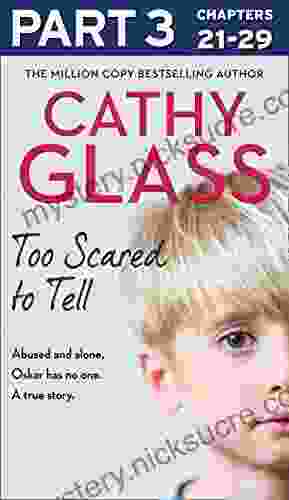
 Mario Simmons
Mario SimmonsToo Scared to Tell: A Harrowing and Thought-Provoking...
In the realm...
4.6 out of 5
| Language | : | English |
| File size | : | 3513 KB |
| Text-to-Speech | : | Enabled |
| Screen Reader | : | Supported |
| Enhanced typesetting | : | Enabled |
| Word Wise | : | Enabled |
| Print length | : | 177 pages |
| Lending | : | Enabled |


